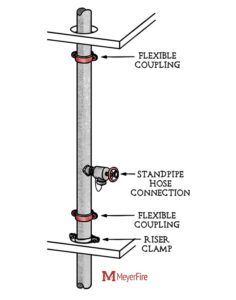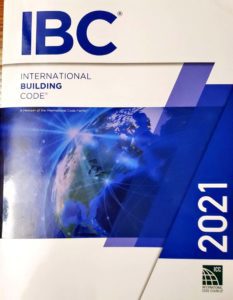When are Standpipes Required for Fire Protection?
When are standpipes required for fire protection? The National Fire Sprinkler Association offers insight into this issue.
The requirements for the installation of standpipe systems comes from locally adopted building and fire codes. The International Code Council (ICC) confirms that all 50 states, the District of Columbia, Guam, Northern Mariana Islands, New York City, the US Virgin Islands, and Puerto Rico have adopted the International Building Code (IBC) for use in new construction. The International Fire Code (IFC) is adopted in 41 states and NFPA 1 – Fire Code in 20 states. The installation requirements for those standpipes can be found in NFPA – 14 Standard for the Installation of Standpipes and Hose Systems.
Standpipes in the IBC
The IBC requirements for standpipes are found in Chapter 9 – Fire Protection and Life Safety Systems, specifically in Section 905 – Standpipe Systems. The IBC has 8 conditions that require standpipes centered around height, occupancy type, and hazard.
1.Height – Section 905.3.1requires a Class III standpipe throughout a four-story building measured from grade plane or when the level of the highest or lowest floor is located 30 feet above or below the level of fire department access.
There are six exceptions allowing only the Class I portion of a Class III standpipe:
a. Class I standpipe is allowed in sprinklered buildings.
b. Class I standpipe is allowed in business and educational groups.
c. Class I manual standpipes are allowed in open parking garages not greater than 150-feet from the highest floor to lowest fire department access level.
d. Class I manual dry standpipes is allowed in open parking garages subject to freezing that meeting the Class II requirements of 905.5.
e. Class I standpipe is allowed in basements provided with automatic fire sprinklers.
f. Class I allowed in buildings where the Class II portion shall not be utilized by trained personnel.
2. Group A – Section 905.3.2 requires the installation of a Class I automatic wet standpipe in all assembly occupancies buildings with an occupant load greater than 1,000.
There are two exceptions to this rule:
a. Open-air-seating without enclosed spaces
b. Class I automatic dry and semi-automatic dry standpipe or manual wet standpipe are allowed in non-high-rise buildings.
3. Covered and open malls – Section 905.3.3 requires malls exceeding the height requirements of Section 905.3.1 for height to be equipped with a Class I standpipe.
The exception allows malls under the height requirement of Section 905.3.1 shall be equipped with Class I hose connections sized to deliver 250-gpm at the hydraulically most remote hose connection and must be able to concurrently supply the automatic fire sprinkler demand. The system shall be designed to not exceed a 50-psi residual pressure loss with the 250-gpm from the fire department connection to the hydraulically most remote hose connection.
4. Stages – Section 905.3.4 requires all stages greater than 1,000 sq. ft. to be equipped with a Class III wet standpipe system.
The exception allows where the building is protected throughout with an automatic fire sprinkler system, a 1 ½ in. hose connection can be installed in accordance with NFPA 13 or 14 for Class II or III.
Note: A 1 ½ in. hose connection designed to NFPA 13 is a hose connection on a sprinkler system and is not a Class II or III standpipe system.
5. Underground buildings – Section 905.3.5 requires Class I automatic wet or manual standpipe.
6. Helistops and heliports – Section 905.3.6 requires Class I or III standpipe to be extended to the roof and adds Section 2007.5 of the International Fire Code (IFC).
a. IFC 2007.5 Adds the additional requirement that all areas of the helistop or heliport is reachable within 150-feet of a 2 ½ in. standpipe outlet.
7. Marinas and boat yards – Section 905.3.7 requires the user to comply with the requirements found in the IFC Chapter-36 Marinas.
a. IFC 3604.2 requires a standpipe to meet the requirements of NFPA 303 Fire Protection Standard for Marina and Boat Yards and requires all areas to be reachable within 150-feet of a standpipe hose connection.
8. Rooftop gardens and landscaped roofs – Section 905.3.8requires building equipped with standpipes, to extend the standpipe systems to the area that the garden or landscaped roof is located.
When are Standpipes Required in Existing Buildings?
 The IBC, IFC, IEBC, and NFPA 1 also have requirements for existing buildings, or buildings under construction or demolition.
The IBC, IFC, IEBC, and NFPA 1 also have requirements for existing buildings, or buildings under construction or demolition.
International Building Code (IBC):
Buildings under construction or demolition, Section 905.10: Requires standpipes to meet the requirements of Section 3311
International Fire Code (IFC):
Existing buildings, Section 905.12, requires standpipes in accordance with Chapter 11 Construction Requirements for Existing Buildings to be in accordance with Section 905.
International Existing Building Code (IEBC):
Chapter 15 Construction Safeguards, Section 1506 Standpipe Systems has pointers back to the IBC Chapter 9 and places additional requirements for buildings under
NFPA 1- Fire Code
Requirements for safeguarding construction, alteration, and demolition operations can be found in Chapter 16 and require compliance of NFPA 241- Standard for Safeguarding Construction, Alteration, and Demolition Operations.
Understanding when standpipes are required is only the beginning of the process of standpipe system design. It makes a big difference once the designer knows where to look. The IBC is the driving code and clearly lays out the eight requirements for standpipes.

